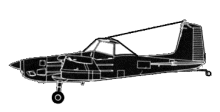
ASN Wikibase Occurrence # 298650
This information is added by users of ASN. Neither ASN nor the Flight Safety Foundation are responsible for the completeness or correctness of this information.
If you feel this information is incomplete or incorrect, you can submit corrected information.
| Date: | Thursday 20 July 2000 |
| Time: | 08:30 LT |
| Type: |  Cessna A188B |
| Owner/operator: | Private |
| Registration: | N731CH |
| MSN: | 18802788T |
| Total airframe hrs: | 5720 hours |
| Engine model: | Continental IO-520-D |
| Fatalities: | Fatalities: 0 / Occupants: 1 |
| Aircraft damage: | Substantial |
| Category: | Accident |
| Location: | STATESBORO, Georgia -
 United States of America United States of America
|
| Phase: | Unknown |
| Nature: | Agricultural |
| Departure airport: | , GA |
| Investigating agency: | NTSB |
| Confidence Rating: |
The pilot stated his personal criteria for making a westerly departure from his 2,000 foot, 2 to 3 percent uphill sloped, grass runway is 8 knots or more of wind from a westerly direction. According to the pilot owners handbook, (POH) the aircraft must be operated in the restricted category whenever it is operated above 3,300 lbs. or with special agricultural equipment. Performance data is limited for operations under the restricted category. Section 4, (Operating Limitations) of the POH contains the following cautionary verbiage with respect to operating in the restricted category, (1) "The adverse effect of soft runways and long grass can only be determined by a series of takeoffs at increasing gross weights on a trial basis", (2) "Conditions of high temperature, high altitude, rough takeoff surfaces, and terrain clearances at the end of the runway should obviously be taken into account in judging the proper takeoff gross weight of this aircraft", (3) "When agricultural equipment is installed, the takeoff ground run will not be effected significantly, but the air distance over an obstacle will be increased appreciably". Takeoff performance data is limited to one chart labeled, "Takeoff Distance with Dispersal Equipment", using the following conditions for its use; sea level, standard atmospheric conditions, zero wind, hard surface, level runway, with flaps 10 degrees. There are no adjustments shown for computing takeoff distances using other than these conditions. Upon attempting a westerly takeoff, the aircraft's tail wheel engaged the top strand of a barbed wire fence, and the aircraft collided with 35-foot pine trees west of the airstrip. The pilot reported engine power appeared insufficient for clearing the trees, but felt or heard no perceptible loss of power output. The engine was sent to the Teledyne Continental Motors factory for teardown inspection, with FAA oversight, and no abnormal conditions could be found in the core engine or its components.
Probable Cause: The pilots failure to calculate his takeoff distance for the conditions, resulting in an in-flight collision with a fence, trees, and the terrain. A factor in the accident is the FAA's failure to require of the manufacturer and the manufacturer's failure to make available in the performance section of the aircraft POH, specific adjustments to the, "Takeoff Distance with Dispersal Equipment" chart for conditions other than sea level, standard atmospheric conditions, zero wind, and hard surface runways.
Accident investigation:
 |
|
Sources:
NTSB MIA00LA226
Revision history:
| Date/time | Contributor | Updates |
|---|---|---|
| 15-Oct-2022 21:01 | ASN Update Bot | Added |
Corrections or additions? ... Edit this accident description
The Aviation Safety Network is an exclusive service provided by:


 ©2024 Flight Safety Foundation
©2024 Flight Safety Foundation